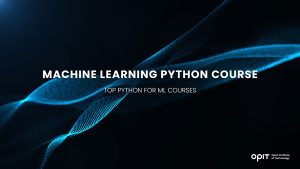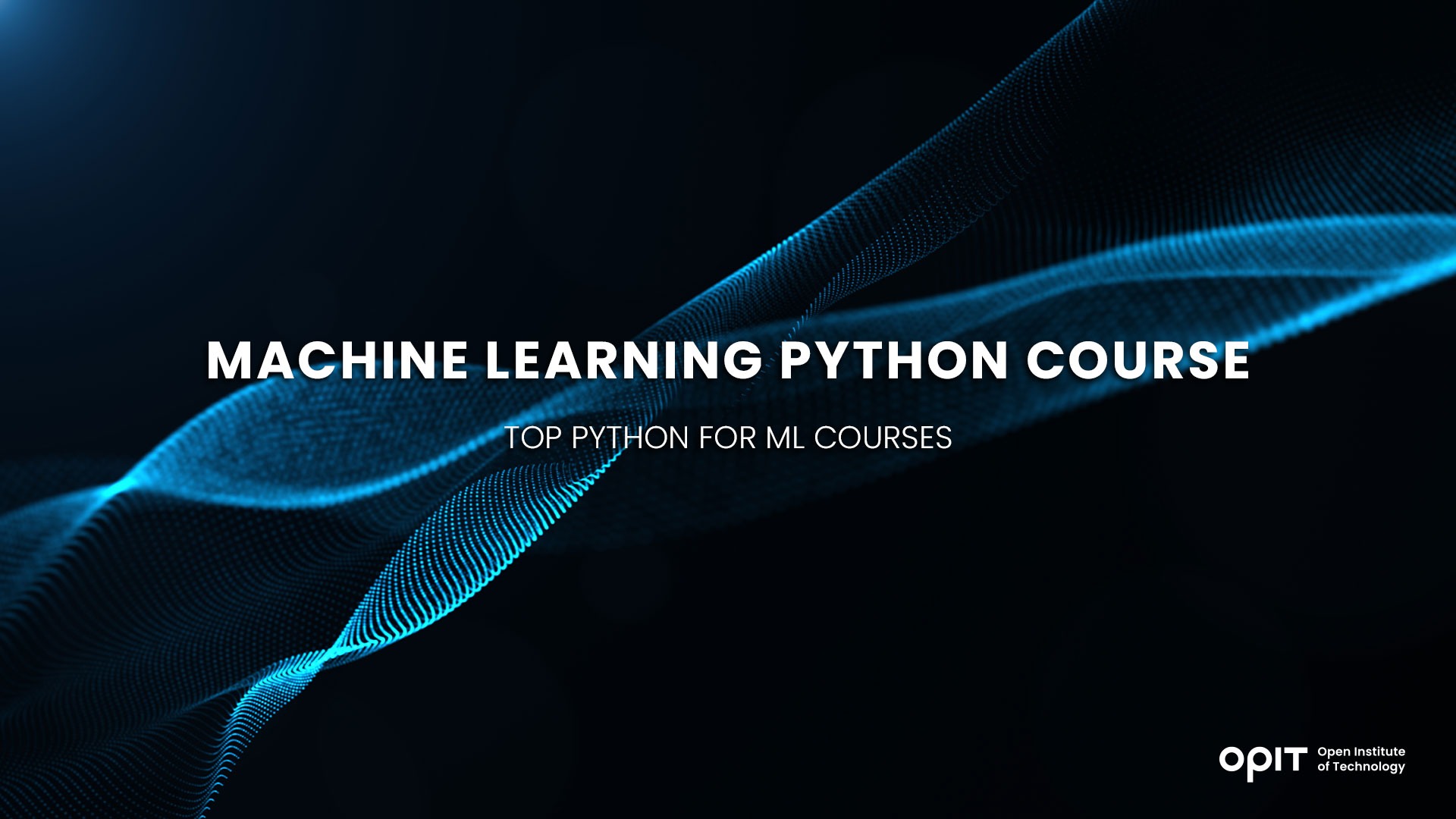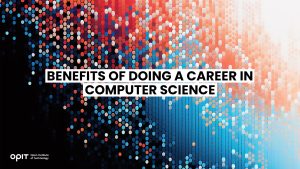

Machine learning (ML) is a branch of artificial intelligence (AI) that focuses on enabling computers to “think” for themselves. Of course, they owe this thinking to humans (data scientists and ML engineers) who continuously supervise ML algorithms and models.
So, there’s no AI takeover (for now at least), just incredible ways to propel several industries forward by automating repetitive tasks, extracting valuable insights from data, and improving decision-making processes.
But how do humans precisely communicate with computers in machine learning?
The answer is through programming languages.
One programming language stands out among the rest for its simplicity and versatility. By the title of this guide, you can already guess we’re talking about Python.
This beloved programming language is all over the machine learning field, so mastering it gives you a great head start in the industry.
With this in mind, let’s examine how you can learn Python for machine learning courses. If you already have some basic knowledge of this programming language, don’t worry. We’ll also mention a great machine learning Python course to take your knowledge to the next level.
Factors to Consider When Choosing a Python for ML Course
Do a Google search for “machine learning Python course,” and you’ll be met with dozens of web pages that promise a sound understanding of this programming language. However, you’ll find the best course for your needs if you can identify those needs first.
Course Content and Curriculum
Your chosen course’s curriculum is arguably the most important factor for selecting the perfect machine learning Python course. One look at the listed topics, and you’ll know whether the course is right for you.
Let’s take your previous experience with Python as an example. If you have none, a course that jumps straight into machine learning algorithms without covering the Python basics will obviously not work for you.
Instructor’s Expertise and Experience
What bridges the gap between struggling to comprehend a complex subject and feeling that nothing can stop you in your learning journey? The answer is simple – a good instructor.
Before committing to a course, check who teaches it. Find out the instructor’s background with Python and whether they have enough expertise to guide you through this programming language’s intricacies.
If their bio checks all the boxes, watch at least one of their lectures. It doesn’t hurt to check whether their teaching style and voice suit you, as these can also make or break your learning experience.
Course Duration and Flexibility
Most online courses are self-paced, allowing you to create your own schedule. Fixed-timing courses also have their benefits, though. They’re usually instructor-led, so you can use the opportunity to ask questions and receive clarification as you learn the material.
As for duration, the course’s description typically indicates how long the course lasts and the recommended pace. Before starting, make sure you can commit to the course from beginning to end. Otherwise, you’re just wasting time and gaining incomplete knowledge.
Hands-On Projects and Real-World Applications
Programming languages are inherently practical, so ensure that your chosen course features hands-on projects and practical examples. Sticking solely to theory will do little to prepare you for what’s waiting in the real world.
Course Reviews and Ratings
You probably check reviews before going to a new restaurant, renting an Airbnb, or purchasing clothes online. So why should shopping for online courses be any different? When a course piques your interest, check how other learners have rated it. But don’t stop at glancing at the average rating. Read through some reviews to ensure they aren’t fake and to get a better picture of the course’s quality.
Pricing and Value for Money
There are plenty of free machine learning resources online. But the more advanced courses and certificates usually come with a fee. And that’s perfectly understandable. What’s not understandable or acceptable are courses that charge ridiculously high fees yet offer little value. To avoid wasting money (and probably time), check whether the course’s price is justifiable by its duration, level, type, and provided support.
Top Python for ML Courses Reviewed
Here are our favorite Python courses primarily focused on machine learning. We’re positive you’ll find the perfect machine learning Python course, whether this is the first time you use this programming language or want to master this skill.
Python for Machine Learning
The Python for Machine Learning course on Great Learning is a great place to start your Python-learning journey. This course is beginner-friendly and relatively short, so you won’t get overwhelmed from the get-go.
This course focuses on three Python libraries: NumPy, Pandas, and Matplotlib. It guides you through the basic concepts (arrays, intersection, loading, etc.) and then moves on to more complex functions. At the end of the course, you take a quiz. Pass the quiz, and you’ll get a certificate of completion.
Applying for this course is free. Not only that, but you’ll also receive free lifetime access, so you can revisit the course whenever you’d like. Although, some learners believe that there’s little to revisit. In total, this course lasts for 90 minutes. Those who are serious about Python learning will probably need more than this.
Still, you can view this course as a beginner’s guide and move to more advanced lessons afterward. To apply, you only need to create an account on the platform and send an enrollment request.
Machine Learning A-Z: AI, Python & R
If you want to start with the basics but cover the more advanced stuff within the same course, this Udemy’s gem is for you. It covers another programming language besides Python, R. However, this won’t be an issue, as you can focus solely on Python.
The course is broken into 10 parts, with over 40 hours of on-demand videos. Each section (and even the lessons within them) is separate, so you can choose to complete the ones that will benefit you now. Start with data preprocessing, and work toward machine learning model selection.
Those seeking practical exercises in Python will love this course. However, you might need to research some notions independently, as not all lecture sections are explained in great detail.
You can purchase lifetime access to this course for $89.99 (a little over €83). The price includes a certificate of completion and several additional learning materials (articles and downloadable resources). Complete the purchase to apply for this course.
Machine Learning With Python by IBM
IBM is one of the leading companies in the machine learning field, so you should take advantage of every chance to learn from its experts. If you’re just gaining your footing in machine learning, you’ll cover all your bases with this offering.
It will take approximately 12 hours over four weeks to complete the coursework. After each lesson, you’ll get a chance to put your newly-learned knowledge to the test.
One thing to keep in mind is that this course focuses more on machine learning using Python than the programming language itself. So, if you’ve never worked with Python, an additional resource or two might come in handy.
You can use Coursera’s 7-day trial to enroll in this course. Afterward, you’ll be charged $39 (approximately €36) a month. The same fee is a must if you want to receive a certificate.
The Complete Machine Learning Course With Python
Are you a data scientist in the making looking to build a solid portfolio with Python? If yes, you’ll love this course. You can find it on Udemy, just like millions of learners before you. This number might surprise you at first. But once you see that one of the founders of this course is Andrew Ng, a thought leader in machine learning, it will make much more sense.
In 18 hours, this course covers all the basics of machine learning with Python. But there’s a catch. You’ll need at least basic Python programming knowledge to keep up.
If this isn’t an issue, create an Udemy account and pay the $59.99 (around €55.50) fee to apply. Lifetime access and a certificate of completion are included.
Programming for Everybody (Getting Started With Python)
While not focused on machine learning per se, this course is necessary for anyone who has yet to work with Python. Pair it with one of the other courses on our list, and your success is guaranteed.
As the name implies, this course covers all the basics. It is designed to allow virtually anyone to follow, regardless of their skills. The simplest math is all you need.
You’ll also need 19 hours to complete this course offered by the University of Michigan. However, the instructor snuck a couple of non-Python-related stories into those 19 hours, which some learners didn’t like.
If you don’t mind a break here and there, join this course on Coursera for free or $49 (a little over €45) if you want a certificate.
Additional Resources for Learning Python for Machine Learning
Perhaps you can’t get enough of learning about Python. Or you find Python for machine learning courses lacking information. Whatever the case, you can find additional resources (both online and offline) to help you master this programming language. Check out some of our favorites:
- Books and e-books: “Python for Data Science, for Dummies,” “Introduction to Machine Learning with Python: A Guide for Data Scientists,” “Python Data Science Handbook: Essential Tools for Working with Data”
- Blogs: Planet Python, Real Python
- YouTube channels: IBM Technology, Google Career Certificates, techTFQ
- Community forums and discussion groups: Kaggle Discussions, Reddit (r/learnpython)
The Path to Python
As you can see, there’s no shortage of Python for machine learning courses, even hosted by some of the biggest names in the industry. Take one of the listed courses or combine them; the choice is all yours. All that matters is that you ultimately master this programming language and crush any data science career you choose.
If these courses aren’t enough to quench your thirst for knowledge, a Bachelor’s in Modern Computer Science will definitely do the trick. With it, you can learn all the ins and outs of Python and machine learning in general.
Related posts

Life is unpredictable. While many of us have specific hopes and expectations of how our futures will turn out, things don’t always go as expected. There are many variables and unexpected incidents that can interfere and force you to alter your plans, and this is particularly true when it comes to education.
For instance, you might have had plans to study a specific subject, but had to deviate from those plans due to unforeseen circumstances. Or you may have had to enter the workforce in an occupation different from the one you sought in an effort to earn an income, a move that may not provide you with the time or opportunity to achieve your desired educational aims.
In short, every individual’s career pathway is different, and very few go exactly as we expect from the outset. Fortunately, even if you experience a few false starts or sudden twists in your pathway, there are always options available to help you get back on track.
The Unpredictable Nature of Education
In theory, the educational process seems simple. You select a course of study that interests you from the vast array of subjects and prospective professions, select the appropriate classes, acquire the knowledge and skills you need to succeed, and then embark on your profession.
In reality, however, as many people know from firsthand experience, the road to education is often far from straightforward. Here are just some of the many challenges that can take your educational path in a completely different direction:
- Life’s Curveballs: As touched on in the introduction, life is impossible to predict. Financial hardships, health issues, and family emergencies are just some of the unfortunate occurrences that might derail even the most perfectly planned educational regime.
- Changing Interests: People’s desires and preferences don’t necessarily stay the same throughout their entire lives. As you grow, learn, and have new experiences, your interests may change, and so, too, may your educational objectives.
- Pressure and Burnout: Some academic paths are particularly challenging, demanding intense levels of study and hard work. This can sometimes prove too much to bear, even for the most resilient students.
- Failures and Setbacks: Conventional education largely builds around tests and examinations, requiring students to demonstrate their competencies repeatedly. It’s a system that doesn’t suit everyone, and test failures can lead to setbacks and delays.
- Inequality: People can be born with very different privileges and levels of access to education. Those in certain parts of the world may find it much more challenging to complete their education path for financial, cultural, or even political reasons.
- Late Bloomers: People develop at different paces. Some may struggle educationally early on in their lives, forcing them to make certain concessions or sacrifices related to their studies, only to find their feet later in life once they’ve entered the world of work.
Whether you’re a late bloomer, have had your educational aspirations delayed by personal problems, desire to learn new skills and try something different, or want to begin a fresh chapter in your professional life, the Open Institute of Technology (OPIT) may be able to help.
Introducing OPIT
OPIT is an online teaching platform, making high-level technological educational programs accessible to all, no matter their age or background. Offering education in fields like computer science, artificial intelligence, and digital business, OPIT provides a curated collection of degrees. In addition, they offer classes taught by world-leading tutors imparting the wisdom and skills students need to achieve their goals and become the tech leaders of tomorrow.
Meanwhile, for those who have had somewhat tumultuous or unpredictable educational paths, OPIT offers the perfect course corrector: the OPIT Foundation Year.
The OPIT Foundation Year
OPIT’s Foundation Year is a Pre-Tertiary Certificate in Information Technology, fully aligned with MQF/EQF Level 4 standards and valued at 60 ECTS credits. Lasting just one year, this program essentially serves as a comprehensive yet accessible springboard towards higher-level education, creating a path towards degrees and careers in dynamic, flexible fields, like computer science and digital business.
Like other OPIT programs, the Foundation Year is delivered entirely online via the OPIT Virtual Learning Environment. Combining live lectures, asynchronous content, and interactive assessments, students enjoy diverse and dynamic study experiences, acquiring core skills like academic writing, mathematics, and computer literacy, and building a bedrock of knowledge and confidence before taking their next steps.
Who Is the Foundation Program For?
The Foundation Program is designed to provide a solid base upon which to build the technological education many students need. It’s the perfect choice for those who are eager and ambitious to enter professions in AI, data science, and computing, but don’t feel that they have the necessary core skills and knowledge needed to dive straight into a degree.
Entry requirements are relatively relaxed in order to allow as many students as possible to enjoy the benefits of this program. With that said, applicants should ideally hold an MQF/EQF Level 3 or equivalent qualification, with the intention of pursuing a bachelor’s degree. A minimum of B2 level of English proficiency is also required, as this is the working and studying language of the institution.
What the Foundation Year Provides
Perhaps you’ve recently graduated, are considering a career change, or finally have the opportunity to return to education after initial delays or unexpected disruptions to your original plans. Either way, the Foundation Year can help you enjoy:
- Greater Self-Confidence: Foundation Year graduates gain the fundamental skills they need to enter degree programs with much more self-belief and assuredness.
- Superior Tech Knowledge: Lasting two terms, this course explores mathematics, academic reading and writing, and provides an introduction to computer hardware and software.
- Foundational Mathematics: Mathematics literacy forms a large part of the study focus for the Foundation Year, helping students feel more comfortable with numbers and formulas.
- Flexible Learning: Unlike more rigid, conventional education environments, OPIT gives you the freedom and flexibility to study at a pace that suits you best, all from the comfort of home.
- Global Community: OPIT is an international institution, with staff and students from all around the world eager to share knowledge, exchange ideas, and help one another.
Take Your Next Steps to Success With the OPIT Foundation Year
If you’re curious about a career in technology or have always wanted to work with AI, data, and computers, but struggled to find the time and opportunities you need to acquire relevant skills and knowledge, the Foundation Program was made for people like you.
It’s the ideal entry point into the exciting world of online education, and the perfect first step towards a prestigious degree from an innovative and increasingly successful institution. Download the brochure to learn more about it, or start your online application, today.

Students today have a broader range of fields of study to choose from than ever before, but with the world becoming increasingly technological and computers increasing in influence and importance, pursuing a career in computer science often proves a smart, strategic choice.
There are numerous benefits and career paths associated with studying and working in computer science, and we’ll be listing just a few of them in this guide.
High Average Salaries
With the rising cost of living in many parts of the world, it’s unsurprising that many students are thinking several decades ahead to determine what level of starting salaries they could obtain in different career fields.
Many are also seeking professions that offer the opportunity for growth and the ability to advance up the ranks over time, thus increasing their salary and their quality of life in the process.
If a strong, stable salary with the opportunity for improved income is one of your top career priorities, computer science should be at or near the top of your list of prospective careers.
According to recent data, computer scientists earn an average of over €65,000 per year, with certain jobs, like IT project leader and data scientist, paying ever higher. Starting salaries are strong, too, with graduates earning anywhere from €46,000 to €60,000, depending on their chosen profession and level of qualifications.
There are similarly high average salaries reported around the world in computer science and related fields such as data science and AI/ML engineering. These numbers are projected to increase in the years to come, pointing to computer science as a way for graduates to get off to the best financial start of any career.
Unrivaled Flexibility
A common problem with some subjects and courses is that they only provide graduates with a narrow set of skills and a similarly narrow range of potential professions to which they can apply those skills.
That’s not the case with computer science. Graduates in this field can enjoy instant access to a remarkably diverse array of career opportunities, with even newer opportunities being created all the time as technology evolves and innovations emerge.
A few of the many industries and roles you might choose to enter in the field of computer science include:
- Healthcare: As a software developer, data analyst, or cybersecurity expert
- Finance: As a fintech engineer, blockchain developer, or security analyst
- Media: As a graphics programmer, AI developer, or game developer
- Education: As an analyst, software developer, or machine learning engineer
Guaranteed Opportunities
Some career paths are more limited than others, with relatively low numbers of opportunities, recurring risks of job loss, or difficulty obtaining employment in the first place.
Again, with computer science, this simply isn’t the case. At a time when 75% of companies plan to embrace AI and other technologies by 2027, and businesses of all sizes and industries are now relying on computers more than ever before, computer science graduates can enjoy almost unbeatable job security.
Opportunities will continue to grow for people with good computing knowledge, whether that be in the obvious fields like software and web development, engineering, and AI development, or more niche sectors.
With so many options, you’re effectively guaranteed a long, rewarding career if you put in the necessary time and effort needed to establish a strong foundation of computing skills.
Rapidly Expanding and Evolving Industries
It’s no secret that the world of technology is a dynamic and fast-moving one. In the past 20 years alone, we’ve seen the proliferation of the internet, the rapid advancement of smartphones and wearable devices, the emergence of AI, and so much more.
In the years ahead, engineers and developers will continue to explore the boundaries of modern technology’s powers and potential, driving new innovations and improvements and opening more exciting job opportunities for those already established and experienced in this field.
Getting into computer science now could therefore provide a solid foundation for a career filled with excitement as you uncover and explore new ways of working with computers in fields as diverse as healthcare, finance, education, entertainment, manufacturing, logistics, and beyond.
Start Your Computer Science Career at OPIT
We’ve discussed some of the many benefits associated with careers in computer science, from the high starting salaries to the rapidly growing array of job options available to graduates. By now, you may be eager to follow this particular career path and take advantage of the wealth of opportunities.
If you’re wondering how to start, the Open Institute of Technology (OPIT) may hold the answers you need. As an exclusively online learning platform, specializing in computer science and digital business, and staffed by some of the world’s leading tech experts, OPIT is producing the tech leaders of tomorrow.
Some of the many advantages of learning with OPIT include:
- Accessible and flexible online education that matches your learning style and schedule
- Heavy focus on real-world applications of the skills you acquire
- An international community of like-minded students from around the globe
- A top team of tutors and lecturers from varying fields and industries
- Progressive assessment of skills and understanding – not constant exams
OPIT offers a small, curated selection of courses for those seeking to gain the technological skills and knowledge to succeed in their chosen areas of expertise. That includes a BSc (Hons) in Computer Science – a six-term program, worth 180 ECTS credits.
Numerous IT industry leaders and experts helped develop this fully accredited undergraduate degree, which is online and accessible to all. Like other OPIT courses, it offers a flexible learning program, with progressive assessments, fast-track options, and the opportunity to be part of a growing community of learners and tutors.
If the benefits of doing a career in computer science interest you, download the OPIT BSc in Computer Science brochure or fill out an online application today and take your first step toward a rewarding and fulfilling profession.
Have questions?
Visit our FAQ page or get in touch with us!
Write us at +39 335 576 0263
Get in touch at hello@opit.com
Talk to one of our Study Advisors
We are international
We can speak in:


